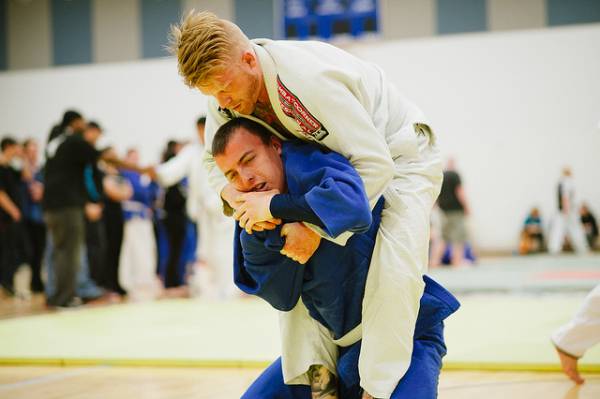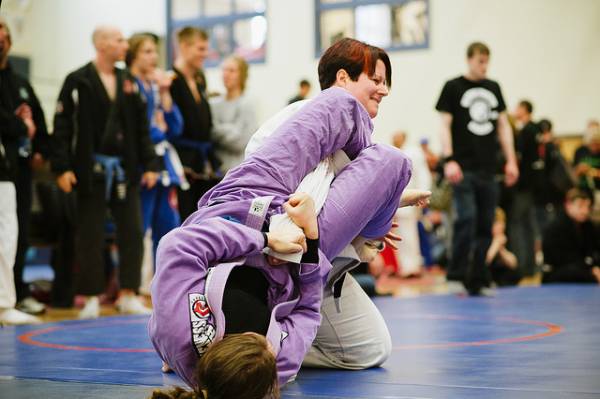They say hindsight is 20/20. I frequently observe, in my own training journey, and in the training journeys of others, actions that reveal how we sometimes don’t know what we don’t know. In other words, while we make decisions, in jiu jitsu and in life, based on the information we have at any given time, we frequently look back on past choices with a bit of chagrin when we view them through the lens of our additional experience. I’ve been thinking recently about how little I knew when I first started training, about pretty much anything jiu jitsu-related. I didn’t know what a Gracie was, I had never heard of the Mundial, and I certainly had no clue about what I was getting myself into. In the spirit of perhaps helping another newcomer to the sport navigate the shoaly waters better than I did, here’s a list of five things I wish I had known when I first started training.
1. It is possible to find a gi and a belt that fit.
How many of you started out your training in a borrowed gi, one that was made for someone six inches taller and thirty pounds heavier than you? One that spilled off your body like a Chocolate Wonderfall from Golden Corral? What about your belt? My first belt was so long I was practically in danger of tripping on it. Especially nowadays, there are scads of gi companies that would love to dress you in a gi that fits. Consider giving yourself maybe a one-month grace period. This allows enough time for a practitioner to fall in love with BJJ, order a gi, and await the arrival of said gi – in the right size.
2. No-gi/gi is just as fun as gi/no-gi.
When I first started training, it was all in the pajamas. I didn’t really try no-gi until a good several years in. Now, I’d be loath to choose which I like better. I’m torn between two lovers. I remember being intimidated by no-gi, though this perspective was probably skewed by the fact that most of the people in the no-gi classes available to me back then were on the larger side. So I assumed no-gi wasn’t for smaller people. (Like I said, I didn’t know what I didn’t know.) On the flip side, I know there are people who have discovered grappling via the no-pajamas route. I encourage you to put on the gi. Even if you are a die-hard gi/no-gi practitioner, think about it this way: Training both modalities is somewhat akin to knowing multiple languages. Knowing a second language gives you valuable perspective and insight on your first language that you wouldn’t otherwise have. So, training the other is actually a demonstration for your love of the one.
3. There is no magic bullet.
 I remember times when work or other obligations kept me from training, and at that early stage of my journey, having to skip a session was like an axe in the heart. Don’t get me wrong; I still don’t like missing training, but I am better able to take it in some kind of stride. I didn’t realize at the time that this is what I was thinking, but when I was first starting out in BJJ and had to miss training, this is what I was thinking: “What if this class session is the one where they teach the ultimate secret to BJJ and I miss it??” Yes, you may miss a good experience if you miss a training session – that’s why you train in the first place – but you won’t miss the magic bullet that catapults you from white belt straight to black. This is because there is no such thing. So you can settle down and just be bummed out rather than beside-yourself frantic.
I remember times when work or other obligations kept me from training, and at that early stage of my journey, having to skip a session was like an axe in the heart. Don’t get me wrong; I still don’t like missing training, but I am better able to take it in some kind of stride. I didn’t realize at the time that this is what I was thinking, but when I was first starting out in BJJ and had to miss training, this is what I was thinking: “What if this class session is the one where they teach the ultimate secret to BJJ and I miss it??” Yes, you may miss a good experience if you miss a training session – that’s why you train in the first place – but you won’t miss the magic bullet that catapults you from white belt straight to black. This is because there is no such thing. So you can settle down and just be bummed out rather than beside-yourself frantic.
4. We don’t have to do anything.
Let me clarify. When we go to class, we have to be respectful and follow the rules of our academy as specified. But otherwise, we are grown-ass adults who are responsible for our own actions. We don’t have to refuse to tap to feed our egos. We don’t have to train so much we hurt ourselves and piss off our loved ones. We don’t have to stay up until 3:00am watching instructionals or competition footage. We may end up doing these things, for better or worse, but it’s up to us to own the fact that we are making the choice to do them, and then to own the corresponding consequences. For instance, if we choose to stay at the academy for two hours later than we told our loved ones we would, it’s not because we had to stay. It’s because we chose to stay. Integrity is (or should be, in my opinion) a central part of any martial art. And owning our actions and their consequences is a central part of integrity. It is very easy to get sucked into the vortex that is Brazilian jiu jitsu, but we have to understand and assume responsibility for the effects this may have on the rest of our lives.
5. Sometimes it’s not about gender.
 Turns out sometimes when the guys didn’t want to roll with me when I was first starting out, it wasn’t because I was a woman, which I wondered. Rather, it was because I was pretty lousy at BJJ. And as I’ve come to discover as my skill has increased somewhat over the years, sometimes I decide I don’t want to train with a certain lower belt dude, not because he’s a dude, but because he’s signaling with his behavior and his words that he’s gearing up for a game of Whose Is Bigger? and I don’t feel like playing. (And rest assured that women can play that game too. It’s an equal opportunity pastime.) The point is, sometimes upper belts make decisions about whom to roll with that may look gender-based but in fact have to do with self-preservation or making the most of limited training time.
Turns out sometimes when the guys didn’t want to roll with me when I was first starting out, it wasn’t because I was a woman, which I wondered. Rather, it was because I was pretty lousy at BJJ. And as I’ve come to discover as my skill has increased somewhat over the years, sometimes I decide I don’t want to train with a certain lower belt dude, not because he’s a dude, but because he’s signaling with his behavior and his words that he’s gearing up for a game of Whose Is Bigger? and I don’t feel like playing. (And rest assured that women can play that game too. It’s an equal opportunity pastime.) The point is, sometimes upper belts make decisions about whom to roll with that may look gender-based but in fact have to do with self-preservation or making the most of limited training time.
The salad days of our grappling careers are almost like the beginning of a romantic relationship. Though the word “heady” is overused to describe that feeling, it’s a pretty accurate depiction of many newcomers’ orientation to BJJ. That feeling deepens among us lifers into a more mature, more sustainable devotion, and as time progresses, we gain more wisdom, perspective, and awareness of what we didn’t know at the start. Ignorance can be bliss, but it can also be a hindrance. There are many other things I wish I had known at the start of my grappling career, but these are just a few.
If you’ve been around the block a few times in the grappling world, what are some things you wish you had known at the start? Post examples to comments.
Photos provided by David Brown Photography.






